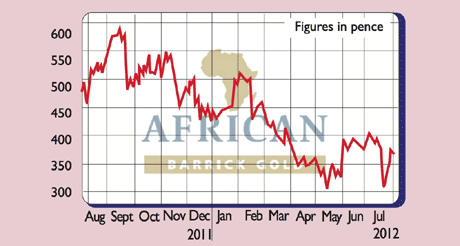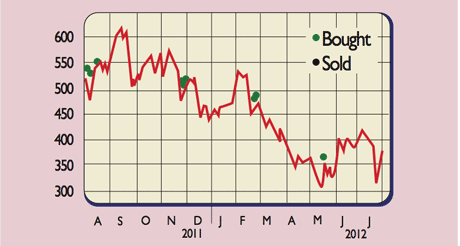Shares in focus: Africa’s largest gold producer
Demand for gold bullion has soared over the years while share prices in gold miners have failed to keep pace. Does that mean African Barrick Gold is cheap? Phil Oakley investigates.
African Barrick Gold is a risky punt for adventurous investors, says Phil Oakley.
The business
African Barrick Gold is the largest gold producer in Africa. Its four gold mines are located in northwest Tanzania, where it is the country's biggest miner. Bulyanhulu, the company's largest asset, is an underground mine. The three others, Buzwagi, North Mara and Tulawaka, are open pit mines. It also has several other development projects in progress. The company has proved and probable gold reserves of just over 17 million ounces. Annual production is currently around 700,000 ounces.
As well as making money from gold, it also gets some income from selling copper and silver, which are byproducts of its gold mining efforts. Canada's Barrick Gold the world's largest producer of gold owns 74% of the firm's shares.
MoneyWeek
Subscribe to MoneyWeek today and get your first six magazine issues absolutely FREE

Sign up to Money Morning
Don't miss the latest investment and personal finances news, market analysis, plus money-saving tips with our free twice-daily newsletter
Don't miss the latest investment and personal finances news, market analysis, plus money-saving tips with our free twice-daily newsletter
The history
The company began to develop in 1999 when Barrick Gold began buying properties in Tanzania. In 2000, African Barrick Gold was formed. The following year saw the Bulyanhulu mine producing its first gold. This was followed by North Mara in 2002, Tulawaka in 2005 and Buzwagi in 2009. The company was demerged from its parent in 2010 at a time when investors were prepared to pay big prices for gold-mining shares.
A rising gold price has seen revenues soar, but profits growth has been more muted in recent years as industry costs particularly electricity and labour have gone through the roof.
Despite promising investors lots of growth from its existing mines, the company has frequently disappointed shareholders as it has struggled to meet output targets. Anyone owning the shares since flotation is currently sitting on big losses.
The chief executive
Greg Hawkins has been chief executive since 2010. He was previously the finance director of Barrick's Asia-Pacific business. He was paid £935,000 in 2011 and doesn't own any shares in the company he leads.
Should you buy the shares?
Not so long ago, gold mining shares were seen as one of the best ways to make money from rising gold prices. Given their large fixed cost bases, rising demand for gold bullion should see miners' profits go up by more than the increase in gold prices. This was borne out in the stockmarket until a couple of years ago.
Since then, the strong relationship between gold prices and the share prices of gold miners has all but vanished and the prices of many stocks have fallen sharply. It seems as if many investors increasingly prefer to own physical gold or gold exchange-traded funds (ETFs). So does that mean that gold miners such as African Barrick Gold are now cheap?
Not necessarily. The company faces many challenges. The Tanzanian electricity supply is often unreliable, meaning that expensive back-up diesel generators have to be used and production can be severely disrupted. Getting skilled labour is not easy either and can be very expensive. As a result, it is costing the firm more and more money to get gold out of the ground.
A few years ago the company was hoping to produce one million ounces of gold by 2014. Despite development projects in Tanzania and Kenya, this looks too optimistic now. It will have to buy more mines to meet this target.
Lurking in the background there's always another hidden threat: the Tanzanian government levying more tax on gold miners.
Finally, and most importantly, there's the issue of future gold prices. If you think the gold price will go up a lot then you might make some decent money buying the shares. If the price goes down, you could still suffer painful losses. Owning physical gold or ETFs is a less risky way to go.
All of this makes African Barrick Gold shares a risky punt for the more adventurous investor.
The numbers

Stockmarket code: ABG
Share price: 360p
Market cap: £1.5bn
Net assets (June 2012): $2.8bn
Net cash (June 2012): $504m
P/e (current year estimate): 9.8 times
Yield (prospective): 2.7%
What the analysts say
Buy: 10
Hold: 6
Sell: 2
Average price target: 457p
Directors' shareholdings

G Hawkins: 0
K Jennings: 44,000
D Pannell: 20,000
Get the latest financial news, insights and expert analysis from our award-winning MoneyWeek team, to help you understand what really matters when it comes to your finances.
Phil spent 13 years as an investment analyst for both stockbroking and fund management companies.
After graduating with a MSc in International Banking, Economics & Finance from Liverpool Business School in 1996, Phil went to work for BWD Rensburg, a Liverpool based investment manager. In 2001, he joined ABN AMRO as a transport analyst. After a brief spell as a food retail analyst, he spent five years with ABN's very successful UK Smaller Companies team where he covered engineering, transport and support services stocks.
In 2007, Phil joined Halbis Capital Management as a European equities analyst. He began writing for MoneyWeek in 2010.
-
 Profit from leisure sector as consumers go on spending spree
Profit from leisure sector as consumers go on spending spreeThe UK leisure sector had a straitened few years but now have cash in the bank and are ready to splurge. The sector is best placed to profit
-
 Nationwide: Annual house price growth slows to lowest level in almost two years
Nationwide: Annual house price growth slows to lowest level in almost two yearsThe average house price went up by just 0.6% between December 2024 and December 2025, Nationwide Building Society said